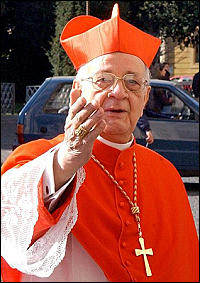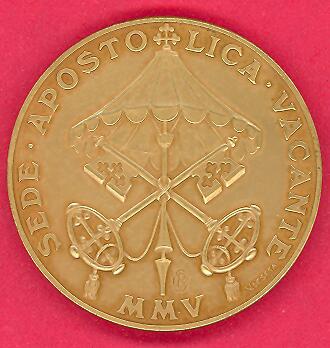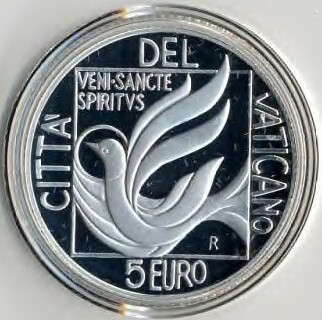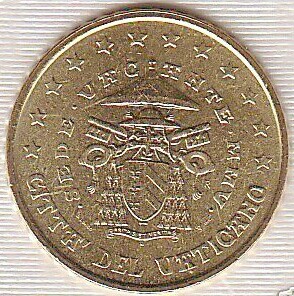SEDE VACANTE 2005
April 2, 2005—April 19, 2005

Eduardo Card. Martínez Somalò
Camerlengo S.R.E.
 |
Æ SEDE • APOSTOLICA • VACANTE • MMV (Engraver:) V. Deseta . Crossed keys, connected by tassels, the Ombrellone above. |
 |
EDVARDVS • CARD • MARTINEZ • S. • R • E • CAMERARIVS (Engraver: ) M. Masini Arms of Eduardo Card. Martinez Somalo, Camerlengo of the Holy Roman Church, surmounted by the Cardinal's Hat with fifteen tassels on each side. His Motto: CARITAS ET VERITAS |
5000 bronze specimens were issued; each is numbered on the rim
 |
AG CITTA | DEL | VATICANO | 5 EURO The Holy Spirit inside a square VENI•SANCTE | SPIRITVS [below the dove: R(oma) mint mark ?] |
 |
SEDE | VACANTE | MMV (Engraver: ) D. LONGO Arms of Eduardo Card. Martinez Somalo, Camerlengo of the Holy Roman Church, on a double cross, surmounted by the Cardinal's Hat with fifteen tassels on each side, the Ombrellone above all.. His Motto: CARITAS ET VERITAS Minter: Momoni Inc. |
 |
50 centos •SEDE•VACANTE• MMV• CITTÀ DEL VATICANO and twelve stars. Arms of Eduardo Card. Martinez Somalò, Camerlengo of the Holy Roman Church, surmounted by the Ombrellone, crossed keys, and the Cardinal's Hat with fifteen tassels on each side. |
EDUARDO CARDINAL MARTINEZ SOMALO was born at Baños de Rio Tobia in the Diocese of Calahorra, Navarre, Spain, on March 31, 1927. He studied at the Pontifical Gregorian University
in Rome, at the Pontifical Ecclesiastical Academy, and at the Pontifical Lateran University, where he received at doctorate in Canon Law. He was ordained in 1950. After pastoral work in his home diocese
he became a secretary in the Secretariat of State at the Vatican and a faculty member at the Pontifical Ecclesiastical Academy. He was briefly counsellor at the Apostolic Delegation in London, until
his appointment as Assessor in the Seretariat of State in Rome (1970-1975). He was sent as Nuncio to Columbia in November 1975, and for that purpose made Titular Archbishop of Tagora. In 1979 he
became Substitute Secretary of State. He was created Cardinal Deacon on June 28, 1988, and served as Prefect of several congregations in the Vatican bureaucracy (Sacraments, Consecrated Life), from which
he retired in 2004. He was named Chamberlain of the Holy Roman Church on April 5, 1993, and retired on April 4, 2007, being succeeded by Tarcisio Card. Bertone, the Secretary of State of His Holiness.
The Dean of the Sacred College of Cardinals was JOSEPH RATZINGER, Bishop of Ostia, of Marktl (Bavaria), who was elected Pope Benedict XVI.
The Master of Papal Ceremonies was Msgr. Piero Marini. He was born in Valverde in the province of Pavia (Lombardy) on January 13, 1942). During the Second Vatican Council he was a consultant on liturgical matters, following the modernist principles espoused by Msgr. Annibale Bugnini. Appointed Master of Liturgical Celebrations on February 23, 1987, in succession to Father John Magee, he was consecrated titular bishop of Martirano (Calabria) by Pope John Paul II on March 19, 1998, and was subsequently elevated to the rank of Archbishop (September 29, 2003). On October 1, 2007, he was appointed President of the Pontifical Committee for International Eucharistic Congresses, in succession to Cardinal Jozef Tomko.
Conclave
The Conclave of 2005 was a notably short one, lasting only two days and four ballots. The opening procession from the Pauline Chapel to the Sistine Chapel took place on Monday, April 18, at 4:30 p.m. In the Sistine Chapel, the solemn conclave oath was administered by Cardinal Ratzinger, and each of the cardinals swore individually as well. At 5:24 p.m. Msgr. Marini proclaimed the "Extra Omnes", and the doors of the Sistine Chapel were closed. There were 115 electors, all of whom were present in the Sistine Chapel, which meant that 77 votes were needed for election. Joseph Cardinal Ratzinger, the Prefect of the Congregation of the Doctrine of the Faith, was the favorite Virtually all of the voting cardinals had been appointed by the late pope, John Paul II, and Ratzinger had been his closest collaborator for more than 22 years. There was a strong sentiment for continuity in policy, since most of John Paul II's appointees had been conservative and loyally Ultramontane in sympathy, and Ratzinger was the person best suited to provide it.
Unconfirmed reports (subsequently taken as fact) has it that there was another candidate, Jorge Mario Cardinal Bergoglio, SJ, of Buenos Aires. This was reported by the Vaticanologist Lucio Brunelli in the journal Limes, ["Cosí eleggemmo papa Ratzinger,” Limes: Rivista Italiana di Geopolitica, September 23, 2005, p. 296], basing his report on the conclave journal of an anonymous cardinal [See also the article in Corriere della Sera, September 23, 2005, "Bergoglio si tirò indietro e Ratzinger fu eletto Papa"]. Bergoglio had not been the original choice of the "liberal" wing of the Church, it seems, but when the real candidate, Cardinal Carlo Maria Martini, SJ, appeared in Rome for the conclave supporting himself with the aid of a cane, he was (as he admitted in an interview close to his death on August 31, 2012) signalling that he was not interested in the Papacy. In fact he had been retired from the Archbishopric of Milan for three years and was suffering from Parkinson's disease. But the touting of Martini and then of Bergoglio opened up fresh wounds concerning the anguish of Paul VI, John Paul I, and John Paul II, in the matter of Jesuit deviance from doctrinal and disciplinary orthodoxy, and may have been a "Rome-speak" way of impugning the memory of the late pope John Paul.
According to the Vaticanologist, John L. Allen, Jr., writing in the National Catholic Reporter on March 3, 2013, "Profile: New pope, Jesuit Bergoglio, was runner-up in 2005" (retrieved March 11, 2013), "After the dust settled from the election of Benedict XVI, various reports identified the Argentine Jesuit as the main challenger to then-Cardinal Joseph Ratzinger. One cardinal later said the conclave had been "something of a horse race" between Ratzinger and Bergoglio, and an anonymous conclave diary splashed across the Italian media in September 2005 claimed that Bergoglio received 40 votes on the third ballot, just before Ratzinger crossed the two-thirds threshold and became pope....He appealed to conservatives in the College of Cardinals as a man who had held the line against liberalizing currents among the Jesuits, and to moderates as a symbol of the church's commitment to the developing world."
The first ballot began around 6:00 p.m., according to the anonymous leaking Cardinal. On the first ballot, despite his own obvious disinterest, Cardinal Martini received nine votes, including those of Patrick O'Brien, Godfried Daneels, and Roger Mahony [Sandro Magister, "Toward the Conclave. the Pressure on the Cardinals," L' espresso March 1, 2013]. These votes were offered, no doubt, as tributes. According to the confidential information leaked so far, at the first scrutiny 47 votes went to Ratzinger, 10 to the Argentine Bergoglio, 9 to Carlo Maria Martini of Milan, 6 to Camillo Ruini (Papal Vicar of Rome), 4 to Angelo Sodano (Secretary of State), 3 to Oscar Rodriguez Maradiaga of Tegucigalpa, and 2 to Dionigi Tettamanzi of Genoa [Sandro Magister, "The Lesson of the Conclave that Elected Ratzinger," L' espresso no. 10 of 2013 (March 7, 2013)].
In Ballot 2, in the morning of Tuesday, April 19, Ratzinger received 65 votes, Bergoglio 35, Sodano 4, and Tettamanzi 2 (Cardinal Baum, the Major Penitentiary, was ill, in the Casa S. Marta). As the Vaticanologist, Sandro Magister saw it, "Ratzinger appeared immediately, therefore, as the only strong candidate. As a result, in the second round of voting the cardinals who had not voted found themselves induced to decide whether to support him or oppose resistance. The votes of Ruini and of others converged upon Ratzinger, who rose to 65 votes, while the votes of Martini and of other opponents went to Bergoglio, who arrived at 35." [Sandro Magister, "The Lesson of the Conclave that Elected Ratzinger," L' espresso (March 7, 2013) (retrieved March 11, 2013].
Later that morning, in Ballot 3, Ratzinger gathered 72 votes, Bergoglio 40, and Dario Castrillon Hoyos (President of the Pontifical Commission "Ecclesia Dei") 1. The vote for Castrillon Hoyos was perhaps Bergoglio's. It was possible that there was a deadlock. Bergoglio had enough votes to ensure that Ratzinger would never reach the required two-thirds-plus-one votes. This "virtual veto" had been used many times before in conclaves. It could not ensure the election of Bergoglio, but it could end the chances of Ratzinger. This is exactly what happened to the prospects of Cardinal Giovanni Benelli in the second conclave of 1978. In the first scrutiny of October 16, Benelli's vote total reached 70, only five short of election, while Cardinal Wojtyla's count rose to 40. But Wojtyla's supporters held firm and continued canvassing, while Benelli's supporters faltered. In the second scrutiny of the day, Benelli received 59 votes and Wojtyla 52. The third scrutiny brought Wojtyla 73, and in the fourth and last ballot he had 97.
It is said, however, that during the lunch period on April 19, 2005, Cardinal Alfonso Lopez Trujillo made the rounds of the South American cardinals, arguing that since Bergoglio could not win, they could do better for themselves by agreeing to Ratzinger. In Ballot 4, in mid-afternoon on April 19, Ratzinger received 84 votes, Bergoglio 26, Christoph Schönborn of Vienna 1, Giacomo Biffi of Bologna 1, and Bernard Law of Boston 1 [Brunelli, in Limes, September 23, 2005]. At 5:30 p.m. the scrutators announced that Ratzinger had received far more than the required 77 votes.
Benedict XVI celebrated the solemn beginning of his pontificate on April 24, 2005, and took possession of the Lateran Basilica on May 7, 2005.
Bibliography
Frederick J. Baumgartner, Behind Locked Doors: A History of the Papal Elections (NY 2003).
David Gibson, The Rule of Benedict (NY: Harper Collins 2009).
Ambrogio Piazzoni, Storia delle elezioni pontificie (Milano: Piemme 2003).